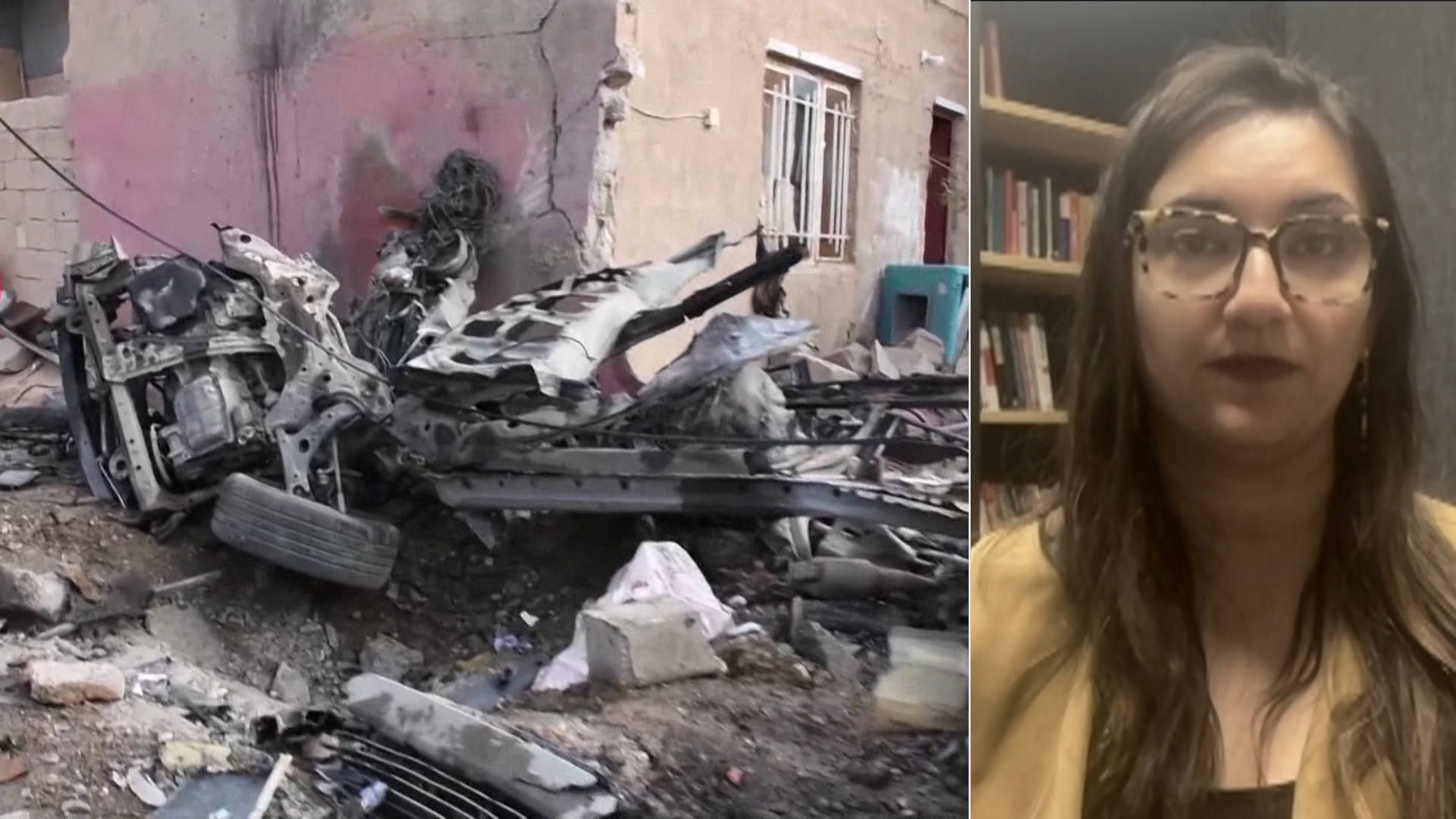This is a rush transcript. Copy may not be in its final form.
NERMEEN SHAIKH: The United States bombed 85 targets in Syria and Iraq on Friday in retaliation for a recent drone strike by Iranian-backed militants on a base in Jordan that killed three U.S. troops. The Pentagon said it used long-range bombers flown directly from the U.S. in its largest action against Iran-backed groups since the Iraq War.
White House national security spokesman John Kirby said Sunday on Fox News that the strikes were just the, quote, “first round” and vowed more would follow.
JOHN KIRBY: I’m certainly not going to talk about potential future military operations. What I would say — and this is a really important point — is what you saw on Friday night was just the first round. There will be additional response actions taken by the administration against the IRGC and these groups that they’re backing.
NERMEEN SHAIKH: Meanwhile, on Saturday, Iran’s interior minister denounced the U.S. airstrikes in Iraq and Syria.
AHMAD VAHIDI: [translated] We naturally condemn any move against the resistance front, and we reject and condemn these attacks that will naturally lead to the flames of the resistance. And they must act wisely, which is very unlikely, and we do not see it in the Americans. If they act wisely, they should stop supporting the Zionist regime.
NERMEEN SHAIKH: This comes as the Syrian Observatory for Human Rights reports six fighters from the Kurdish-led Syrian Democratic Forces were killed in an overnight attack Sunday on a U.S. base in eastern Syria. Today, Iran’s security chief, Ali Ahmadian, has arrived in Baghdad for talks to address the escalation in fighting.
Meanwhile, the U.S. bombed Yemen again on Saturday and Sunday, targeting sites controlled by Houthi forces who have vowed to keep targeting ships linked to Israel and the United States until Israel halts its assault on Gaza.
For more, we’re joined by Narges Bajoghli, professor of Middle East studies at Johns Hopkins University. She co-authored the new book titled How Sanctions Work: Iran and the Impact of Economic Warfare and is also the author of Iran Reframed: Anxieties of Power in the Islamic Republic. Her recent co-authored piece in Foreign Affairs is headlined “How the War in Gaza Revived the Axis of Resistance.”
Welcome back to Democracy Now!, Narges. If you could begin by responding to the latest news over the weekend, the U.S. launching airstrikes in Syria, Iraq and Yemen, and the Biden administration vowing more attacks are to come, and, in particular, on Friday, the U.S. striking dozens of targets, for the first time hitting facilities linked to Iran’s Revolutionary Guards, Narges?
NARGES BAJOGHLI: Sure. So, with the killing of the three U.S. servicemen in Jordan in Tower 22, that is one of the U.S.’s stated red lines in the region. And that’s been something that throughout the past three-and-a-half months, as well as the longer sort of shadow war between Iran, Hezbollah, the U.S. and Israel in the region, that’s been a red line that has been observed quite firmly by the forces that are fighting against the United States and Israel.
Now, with the three servicemen who were killed, it was obvious that the U.S. had to respond. The fact that they responded in the ways that they did, but that Iran very quickly announced that no Iranians had been killed, signals — they are signaling back to the U.S. that they understood that the retaliation had to happen, but that they are not escalating at this moment because their own fighters had not been killed.
NERMEEN SHAIKH: And, Narges, could you explain what were the locations? The U.S. hit 85 targets at seven facilities in Iraq and Syria. What were the locations that were hit? As you said, Iran has said there were no Iranian casualties, but, of course, there were Iraqis and Syrians who died. Talk about the significance of the fact that in the Iranian media it was made clear that there were no Iranian casualties, and also explain the targets that were hit by the U.S.
NARGES BAJOGHLI: Sure. So, the targets that were hit were logistical centers, command centers, spaces that weaponry are stored. And these are sites that are linked to militias that are a part of what is called the Axis of Resistance from — on behalf of Iran and its allied forces in the region. So these are spaces that the U.S. identified and at least stated that they, these locations, are backed by the Iranian Revolutionary Guard, and they are belonging to militias that are fighting against the U.S. and Israel in the region.
And the significance of the fact that Iranian media claimed very quickly that no Iranians had been killed in the attacks is because Iran had said that their red lines — they have two major red lines in the region for escalating this into a broader war. One is any kind of strike on Iran’s territorial — within Iran’s territory or on its bases, and the second is the killing of Iranian personnel and fighters. And so, this was a — very quickly after the attacks, they announced within Iranian media that people had been killed, especially Iraqis and Syrians that were tied to these various militias and groups, but that no Iranians had been killed. So that was a very clear signal to say, “We understand your response, but we will not escalate at this moment.”
NERMEEN SHAIKH: And, I mean, to talk more about that phrase “the Axis of Resistance,” you have said that Iran-backed groups or Iran proxies has been in the headlines — those phrases have been in the headlines for decades. Is that, in your view, an accurate rendering, especially in light of the fact that you’ve made the argument that in this case, following Israel’s assault and ongoing assault on Gaza, it’s Hezbollah that has really taken the lead, because it recognizes that the core issue now is Palestine?
NARGES BAJOGHLI: So, the Axis — or, what’s called the Axis of Resistance, sort of the seeds of it began after the U.S. invasion of Iraq in 2003. And the reason for that was that the U.S. at the time, under the George 2 administration, was very clear and very loud that the next country after Iraq would be Iran. So, what Iran’s Revolutionary Guards Quds Forces, which are their extraterritorial forces, which at time were under the command of Qassem Soleimani, their strategy became to create militias within Iraq that would, in essence, bog down the U.S. in Iraq and not allow it to turn its focus then on the Iranians.
Eventually, throughout the 20-odd years of the “global war on terror” in the region, as the battlegrounds spread throughout the region, Iran also began to form and give training to and funding to and weaponry to different militias throughout the region, at first mostly sort of Shia militias, but that began to expand into nonsectarian forces. Iran’s Revolutionary Guard and Lebanese Hezbollah have been very instrumental in creating what is now — what they now term the Axis of Resistance, which includes not only Iran and Hezbollah, Syria itself and militias across Iraq, as well as the Houthis in Yemen, and then, of course, Hamas in the Gaza Strip and civilian resistance groups within the West Bank. These are all sort of under the umbrella of what is called the Axis of Resistance.
Now, I think what’s really important to note is that these are not proxy groups of Iran. From the get-go, the Revolutionary Guard has set up these groups to be decentralized. And then, after the assassination or the killing of Qassem Soleimani by the Americans under the Trump administration in 2020, his successor has decentralized these forces even more. So what that means is that all of these forces are aligned with Iran and Hezbollah’s mission to drive the United States out of the Middle East and to fight against what they deem to be Israeli colonialism, not only just over historic Palestine, but more broadly across the region. So that is first and foremost. But all of these groups are also involved in this axis for their own local interests, because they see the United States and Israel involved within their borders and within the fights that they are involved in locally. So, the axis, in essence, yes, it follows upon Iran’s strategic interest in the region, but it is a decentralized axis. They make their own decisions. They coordinate at the top. But it’s not as easy as Iran says do this, and then the members of the Axis of Resistance follow.
NERMEEN SHAIKH: And, Narges, could you talk about the extent to which you’ve pointed out that neither Iran nor the U.S., as officials from both countries have said, are not interested in escalating, much less in coming into direct conflict — that is, the U.S. and Iran? But many have been concerned that, you know, at this point one false move could set the entire region alight, and especially so given that, as many have said, yourself included, that Israeli Prime Minister Benjamin Netanyahu is actually creating the conditions for the U.S. and Iran to have a direct confrontation. If you could talk a little bit about that and what you think the impact of this might be?
NARGES BAJOGHLI: Yeah. So, at least from the perspective of whether it’s within Iran or Hezbollah, the reading from their perspective of what is going on in the region is that as the Israelis have had a difficult time getting to their strategic objectives within Gaza, there is a desire on the behalf of Bibi Netanyahu to expand this war into one that would drive and drag the United States more fully into it, especially in direct confrontation with Iran, because from the point of view of Israel and Israeli leaders sort of, and this is what Netanyahu has stated, is that Iran is the head of what they call the octopus. Right? And so, their desire is to say that in order to deal with what is going on in the region and this multipronged attack that is happening on Israel from across various borders, Iran needs to be dealt with directly.
Now, the United States does not want to get involved in a direct confrontation with Iran, because it’s not just a direct confrontation with Iran, as the Axis of Resistance kind of makes clear. What Iran’s strategy has been since the start of the “global war on terror” by the United States in the region has been to create a network of spaces in which, if the West were to get involved, it would be not just a war with Iran, it would be a war across the region. That is what makes this moment extremely dangerous, is because, as you said, there could be miscalculation on either end, and it could actually develop into something much larger. So, although the United States is saying that they don’t want to get involved in another large Middle East war, and they instead want to focus on China and sort of on a different part of the world, Iran has also made the same claim, that it does not seek to get into a larger war.
Now, what’s important here is to note that both Iran and Hezbollah, although they are striking back against Israel and different kinds of U.S. forces or sort of bases across the region, what they are trying to do is to put enough pressure on the U.S. and to create enough global sort of outrage about what is going on in Gaza in order to put public pressure on the United States to retreat from the region, because it knows that — you know, Iran and Hezbollah and the other forces know that it will be extremely difficult and they cannot take on the U.S. militarily. But what they are hoping to do is to create enough public pressure, because of what is happening in Gaza, to force the U.S. to reconsider its strategies over these past few decades in the Middle East.
NERMEEN SHAIKH: And finally, Narges, you talked about this, the increasing support for this Axis of Resistance in the region. If you could speak, as you did in your Foreign Affairs piece, of the role of the war in another domain, that is to say, in media, and, in particular, social media, that is ongoing now, that is kind of changing the nature of the conversation in the Middle East about this war?
NARGES BAJOGHLI: Right. So, both Nasrallah, who is the commander of Hezbollah in Lebanon, and Khamenei, who’s the supreme leader of Iran, have been very clear in saying that their main objective — that they will not get into this larger sort of, what they call, trap that Netanyahu is laying for them to engage more directly with the United States, and instead they want to keep Palestine at the forefront. Now, why are they saying that? Not only because of what is happening in Gaza and their sort of allyship with the Palestinians, but more than that also is the fact that Palestine, as an issue, has become a global issue for the first time in many decades, and because of social media, it has broken through much of the narrative of how conflict in the Middle East more broadly, but especially Israel-Palestine, has been sort of talked about and understood on a global stage. It’s now no longer about fighting Islamic terrorism, but there’s a more global understanding that this is an issue that is related to occupation, apartheid and settler colonialism.
For why is this important for the Axis of Resistance, it’s because, for decades, they have been involved in fighting the United States and Israel in the region, but, narratively, they have just been sort of deemed as terrorists or bad actors or maligned actors that are fighting against the United States. For the first time pretty much in their existence over the past four decades, for the first time the causes by which at least they claim to be fighting for, which is driving the United States out of the region and finishing off Israeli colonialism, for the first time that is being understood globally not in the language of Shi’ism or sort of religious and Islamic ideology, but in the language of human rights and in the language of genocide and international law. So, for these reasons, this has been a really important war for this axis. But also, secondly, Hamas itself has been quite adept at utilizing media very, very effectively in communicating what it is both facing and what it is up against in the region, as well as, obviously, the many Palestinian journalists and influencers within the Gaza Strip and across the region who are tapping into a global sort of moment of deeper and deeper understanding of the kinds of geopolitical forces that are at play both in the Middle East and beyond.
So there’s a confluence of things that are going on, but that confluence in this moment has been to the benefit of the Axis of Resistance. And this is something that they’ve been working on for a very long time to be able to develop multilingual media that essentially is able to utilize social media as a strength to communicate broader ideologies about what is going on in the Middle East and move it out of the narrative terrain of the “global war on terror,” which is the U.S. and Israel fighting Islamic terrorism, and it’s been able to reframe all of that into a language of hegemony and colonialism, and settler colonialism specifically, and apartheid.
NERMEEN SHAIKH: Thank you so much, Narges Bajoghli, professor of Middle East studies at Johns Hopkins University and co-author of the new book How Sanctions Work: Iran and the Impact of Economic Warfare. She’s also the author of Iran Reframed: Anxieties of Power in the Islamic Republic. Her recent co-authored piece in Foreign Affairs is headlined “How the War in Gaza Revived the Axis of Resistance.”
When we come back, we speak with Senator Bernie Sanders’ former foreign policy adviser, Matt Duss, and speak with a Palestinian American doctor who just declined to meet with U.S. Secretary of State Antony Blinken.
[break]
NERMEEN SHAIKH: “The American Ruse” by MC5. The group’s founding member and guitarist Wayne Kramer passed away Friday at the age of 75.











Post comments (0)